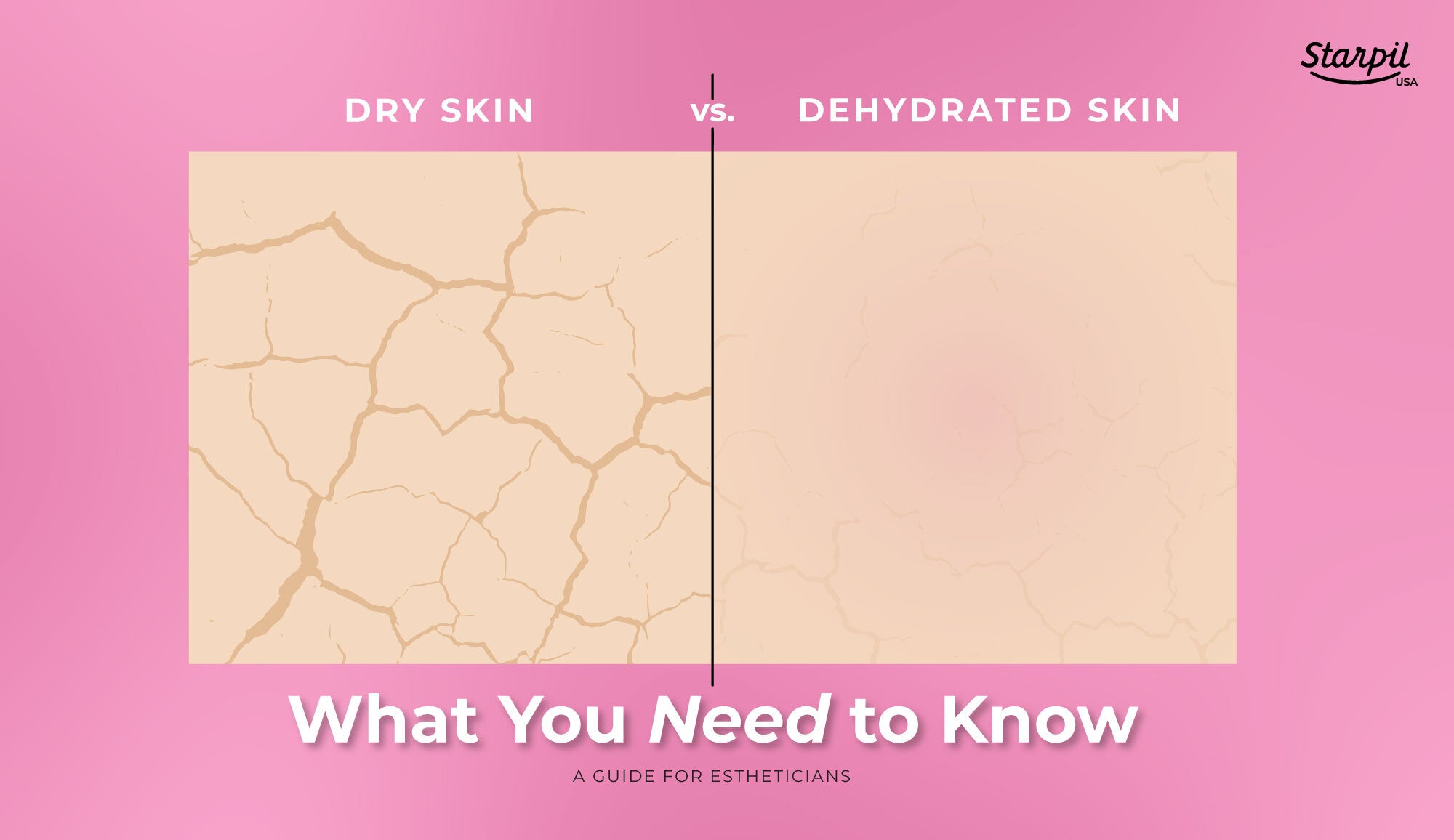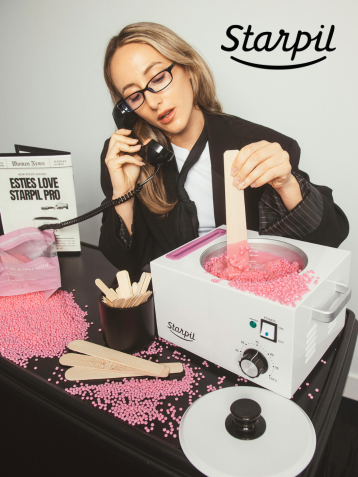Working with Dry vs. Dehydrated Skin: A Guide for Professionals


When looking into the right skincare routine or waxing products for your skin type, it can often be hard to spot the difference between dry and dehydrated skin.
Even for professionally trained estheticians, clients’ fluctuating skin states can be difficult to identify and keep up with to properly treat daily, especially if they’ve tried treatments before which have damaged their skin or its barrier.
So how do you tell if you or your clients have dry or dehydrated skin? When going through tons of searches to match skin’s characteristics with the descriptions of the different skin types out there, it can be easy to mismatch or mistake the skin’s symptoms for the wrong type. Especially if you’re not sure what to look for, the aspects of each skin type can easily overlap with one another.
Table of Contents
The best way to determine whether the skin is dry or dehydrated is to see a dermatologist, but for most skin types, you’ll be able to recognize and cultivate the right routine for yourself with the right tools and the right research. `
Though dry and dehydrated skin can easily be confused with one another, we’ll run you through the characteristics and causations of each so you can form the right treatments to keep skin in its best condition. We’ll also fill you in on all things waxing for both skin types so you can leave flaky skin and annoying or inconvenient hair alike in the past.
READ: Introducing Maystar Essentials Skincare
Is My Skin Dry or Dehydrated?
When figuring out how to tell if the skin is dry or dehydrated, it can be easy to confuse the characteristics of each type. Many even think these skin types are just the same thing.
When looking at the difference between the two, dry and dehydrated skin are two conditions with some overlapping characteristics and some that differ.
Let’s get into what makes these skin types unique from one another and what causes each so you can form the proper treatment and routines.
Generally speaking, if you’re looking for the difference between dry and dehydrated skin, the biggest factor that differentiates the two is that dry skin occurs when there’s a lack of oil present in the skin, whereas dehydrated skin results from a lack of moisture or hydration in the skin.
Both of these skin types can be genetic or caused by external factors.
READ: Waxing and Dry Skin
What is Dry Skin?
Dry skin is a skin condition characterized by the appearance or feeling of scaly, itchy, cracked, or flaky skin.
Many people’s skin can fluctuate between dry and oily in nature depending on a variety of internal and external factors, but for those with primarily dry skin, there are many different ways to tackle treatment.

Though people often talk about dry skin when it comes to the face, this skin type can occur on any part of the body. Lifestyle changes, the climate, and even washing your hands too much can make the skin become dry or just dry out a bit from its normal state.
Outside of a general definition of dry skin, there are a couple of different kinds of this skin type: one is regular dry skin, which can be genetic or environmental. Besides that, there’s also dermatitis, which is extremely dry skin that needs to be treated medically. There are also medical conditions, such as eczema or contact dermatitis, that fall into the umbrella term of dry skin.
What Causes Dry Skin?
Now that we know what dry skin is, let’s determine where the root of it is. Because dry skin often goes beyond that of dehydration, its causations can be very different from that of skin just lacking hydration.
People who experience dry skin typically have a weak lipid barrier, which can lead to dryness and eventually dehydration. A lipid barrier is a barrier on the skin’s outer surface that protects against both internal and external factors that might contribute to the drying of the skin.
Strong lipid barriers lock in moisture and hydration for the skin, and guard skin from UV rays, radiation, pollution, excessive heat or cold, and other environmental factors.
If the barrier is weakened or naturally not strong in the first place, skin can be left susceptible or vulnerable to drying or dehydration. Weakened lipid barriers can be caused by several factors. Aging, changes in seasons or the climate, using harsh cleansers or over-exfoliating, dietary changes, stress, UV ray exposure, and even some illnesses can all contribute to damaging this barrier.
Is Dry Skin Genetic?
Dry skin, especially more severe dry skin conditions such as dermatitis or eczema are genetic and can be treated medically or with the right skincare routine.
Genetically dry skin can be lacking in natural moisture or is due to a naturally weakened lipid barrier.
Both of these factors can impact the skin’s ability to naturally produce oils to keep the surface moist and protected. Remember, though dry skin might lack moisture, its actual cause is a lack of oil production, which then causes dryness and a lack of ability to retain the moisture your body produces.
Is Dry Skin Environmental?
The skin’s lipid barrier can be easily impacted by environmental factors, including seasonal changes, a particularly hot or cold climate, or harsh, ongoing weather conditions. UV exposure and pollution can also cause the skin to be dry.
Another external factor that can significantly contribute to the drying out of the skin is over-stripping the skin by using harsh cleansers, exfoliants, or chemical treatments on the skin.
Though these treatments and those who use them have good intentions, if you’re not seeing or consulting a professional before attempting to correct skin’s dryness using a rigorous or aggressive skin routine, it could, unfortunately, make the problem worse and damage the skin lipid barrier.
READ: How to Get Rid of Oily Skin
What is Dehydrated Skin?
Just as dehydrated skin can be mistaken for dry skin, it can just be easily overlooked when people research causations of their oily skin. So how can dehydrated skin be mistaken for both skin types, and what characteristics does it have? Let’s first tackle what dehydrated skin is, and then look into the possible causes of the skin type.

Dehydrated skin is the drying of the skin due to a lack of moisture or hydration. Though dry skin is caused by a lack of oil production in the skin, those with dehydrated skin usually have normal levels of oil production but lack the moisture needed to keep skin balanced. This can lead to an overproduction of oil in dehydrated skin, as the body attempts to overcorrect to keep the outer layer moist.
Dehydrated skin is characterized by sensitivity, flakiness, itchiness, redness, oiliness, tightness, and dullness. Those with this sort of skin can experience all of these symptoms, or just some depending on their level of dehydration. Those with both dry and oily skin alike can have dehydrated skin simultaneously with their normal skin type, so it can often be hard to identify without a knowing eye.
READ: Working with Different Skin Types
What Causes Dehydrated Skin?
Dehydrated skin can be caused by a variety of internal and external factors, including issues ranging from not drinking enough water to medical treatments and environmental factors.
There are two types of water found in the skin: static and dynamic water. Static water is a fixed amount of water in the skin, whereas dynamic water circulates throughout the epidermis. These types of water should be balanced to keep skin in its best condition.
A lack of hydration in the skin can disrupt the skin’s natural barrier, cause an overproduction of oil, or can result in dry, flaky, tight, or uncomfortable skin.
External Causes of Dehydrated Skin
Dehydrated skin isn’t genetic, and is usually caused by a variety of external factors. Because dehydration can happen to those of any skin type, it can often go unnoticed, and fluctuate from time to time depending on a variety of external issues. The biggest of these is general dehydration or lack of water consumption. If the skin appears to be dehydrated, the first thing to try to figure out is whether you’ve been consuming enough water and staying properly hydrated.
Dehydrated skin can also be caused by excessive cold, wind, pollution, and UV ray exposure. Lifestyle choices like taking very hot showers every day or even just being in air-conditioned environments for long periods can contribute as well. Like dry skin, stress or fatigue can also contribute to your skin’s condition. Smoking cigarettes or consuming excessive amounts of alcohol can also lead to your skin becoming very dehydrated.
As is the case with dry skin, using cosmetic products like harsh cleansers or too strong of exfoliants can also strip or remove moisture from the skin and cause it to become dehydrated.
READ: How to Get Rid of Textured Skin
How Do You Care for Dry or Dehydrated Skin?
Treatment options for dry and dehydrated skin differ, since dry skin is often genetic and dehydrated skin is more circumstantial. Before you begin any significant treatment routines for either skin condition, you should always consult a professional esthetician or dermatologist to ensure you’ve identified your skin type correctly and aren’t further damaging the skin’s lipid barrier.
There are tons of products out there touted as being the correct treatment approach for dry and dehydrated skin alike - but do they really work? Let’s tackle the different products and treatments best for dry skin, and how to help dehydrated skin as well.
Treating Dry Skin
If your dry skin isn’t severe, or one of the medical conditions we mentioned earlier, there are a variety of approaches to take to improve dry skin. If you experience very dry skin or have genetic factors at play, consult a dermatologist or skincare esthetician before making significant changes to your skin routine.
When cleansing dry skin, always use a gentle, alcohol-free cleanser twice a day, and cleanse skin after activities that cause excessive sweating. If your skin is also very sensitive, only cleanse at night and rinse skin with water in the morning and during other times. If your skin is acne-prone, also avoid cleansers and moisturizers that do not contain oil or ingredients that specifically could cause inflammation to your skin.
Use a moisturizer containing SPF or a separate cream-based sunscreen on your face and reapply every couple of hours. Look for moisturizers that incorporate shea butter, and fatty acids, and also ones that are free of fragrances or ingredients that could inflame skin.
If your skin is very dry, try using a heavier moisturizer or an oil, especially at night. Never wash the face or bathe your body in very hot water - only warm or lukewarm water to protect the skin and its lipid barrier.
Best Skincare Products for Dry Skin
If you’re looking for the best skincare products for your dry skin, finding the formulas that will balance and nourish your skin daily without breaking the bank will put you on the right track in getting your skincare right.
Dry skin products like Maystar Essentials’ Moisturizing Face Cream, Moisturizing Body Lotion, or Skin Hydration Kit. These products will moisturize and hydrate your skin and leave it feeling soft and supple when incorporated into a daily skincare routine.
Treating Dehydrated Skin
Having dehydrated skin often comes down to a combination of external factors, but the good news of this situation is that there are tons of approaches to take to improve your skin’s moisture retention.
To treat dehydrated skin, first try to increase your base water consumption, and make dietary changes to incorporate more food and beverages that contribute to hydration instead of taking away. Think of incorporating more fruits and vegetables into your diet, and try to swap out coffee with tea or at least balance caffeine and coffee consumption with hydrating beverages. Try to limit smoking or alcohol consumption, as these can also easily dehydrate skin.
As far as your skincare routine goes, try to use only a gentle cleanser on your skin with lukewarm or warm water. Never wash your face with very hot or cold water, as this can contribute to damage to your skin barrier. Use a gentle exfoliant on your skin weekly, and never daily. Stay very far away from harsh facial scrubs or exfoliants that can strip the skin.
Use a hydrating essence on your skin after washing your face at night to lock in hydration and add water back into your skin. Lock this in with a hyaluronic serum or night moisturizer.
During the day, use a gentle daily moisturizer with SPF, or use a moisturizer and an oil-free sunscreen.
For both dry and dehydrated skin, investing in a humidifier could help increase your hydration and let your skin feel less tight, itchy, and more comfortable. For dry or dehydrated skin on the body, also try to only wear natural fabrics that are loose, airy, and comfortable. Stay away from detergents that are heavily fragranced or that incorporate dyes that could irritate your skin.
Best Skincare Products for Dehydrated Skin
Whether your base skin type is dry or oily, you can also treat dehydrated skin and replenish hydration with the right daily skincare products, as well as the lifestyle regimen changes we mentioned prior.
For the best dehydrated skin products, see what difference the Skin Hydration Kit can make for your daily skincare regimen and when looking to replenish your skin’s water retention. For dehydrated skin that overproduces oil in an effort to balance skin, calm this product and even out oil production with the Maystar Oil Balance Treatment Gel and Oil Balance Face Lotion. Using the Exfoliating Facial Scrub as part of your routine will also free you from rough skin texture and uneven tone.
For dehydrated skin that’s excessively oily and acne prone, you can also use the Acne and Oil Balancing Kit to free skin of congestion and nurture a clear complexion.
READ: Best-Post Wax Care Tips
Waxing Dry vs. Dehydrated Skin
If you have dry skin, or are experiencing dehydrated skin, you might wonder how these factors could impact your waxing routine. If you are concerned about how your skin could react to waxing, consult your esthetician to see how they can better approach your waxing services.
For estheticians looking for the right way to provide waxes for those with dry and dehydrated skin, there are several ways to give clients their best results without irritating, inflaming, or otherwise damaging their skin.
Best Waxing Products for Dry & Dehydrated Skin
There are several products for both waxing and for pre and post-wax care that can help to keep dry and dehydrated skin in its best condition.
Pre & Post-Wax Care for Dry or Dehydrated Skin
Before going into a waxing service, clients should always perform the right preparation to have skin in its best condition for hair removal. For those with dry skin, using Starpil’s cleansing yet hydrating Pre-Wax Gel will help to gently exfoliate skin without disturbing the lipid barrier.
For those with dehydrated skin, or those with sensitive skin, using Starsoft or Calendula Pre-Wax Gel to cleanse the skin’s surface and provide adequate hydration and moisturization. These formulas are especially made to protect sensitive skin and form an additional barrier to protect skin during a waxing service.
Following a waxing service, it will help to not only preserve waxing results, but jumpstart cell repair and skin recovery and rejuvenation by using Post-Wax Lotion and Post-Wax Oil.
Our Starsoft and Calendula lines also aid sensitive skin in locking in hydration, moisture, and in protecting and repairing the skin’s cells and barrier following a waxing service.
Best Waxes for Dry or Dehydrated Skin
There are a variety of waxes ideal for use on dry or dehydrated skin. These speciality hard waxes will provide amazing hair removal results without irritating, inflaming, or otherwise hurting these delicate skin types and conditions.
Like our pre and post-wax care items in these same lines, Calendula and Starsoft Hard Waxes provide complete hair removal for sensitive skin types while protecting against inflammation, irritation, redness, as well as breakouts and ingrown hairs. These hard waxes for dry skin and dehydrated skin are specially formulated to provide hydration, moisturization, and to soothe these skin types.
Vegan Hard Wax is also fantastic for use on dry, dehydrated, and sensitive skin. The natural ingredients used in this formula, including shea butter, olive and sweet almond oil and more will moisturize and hydrate skin while providing amazing hair removal results.
If you’re looking to detoxify and brighten your dulled, flaky, or irritated skin while receiving great waxing results, Coral Hard Wax is the way to go. This formula uses Mediterranean Coral and calcium powder to brighten skin and will allow you to get both a skincare and waxing experience all in one. This wax mimics sugaring and reduces redness and irritation for those with not only dry and dehydrated skin, but hypersensitive skin as well.
READ: How to Become an Esthetician: The Ultimate Guide
Final Thoughts
Whether you have dry or dehydrated skin, there are plenty of treatment options out there for you to tackle the skin issues you might be experiencing. Now that you’ve understood the difference between dry vs. dehydrated skin, and how both genetic and environmental factors can play into the development and treatment of each, you can properly approach your skincare and waxing routine alike in a way that helps skin, instead of further stripping or damaging it.
Understanding your skin type or skin condition is key to forming the right care routine and in keeping your skin in the best condition it can be, and in improving any issues you might experience with your skin. If you approach your skincare and waxing routine with these factors in mind, you’ll be set up for both everyday and waxing success!















